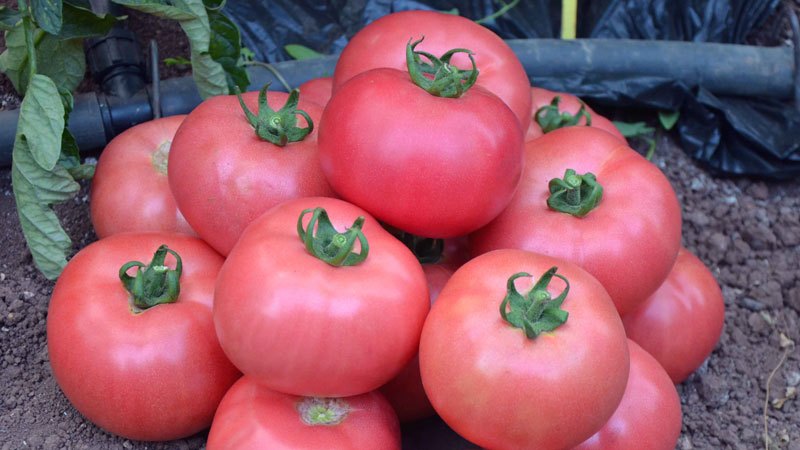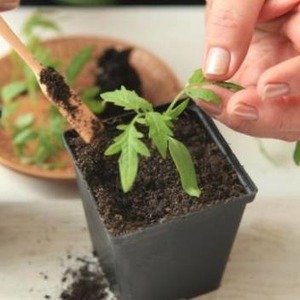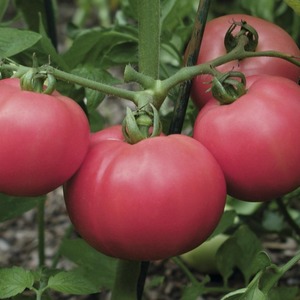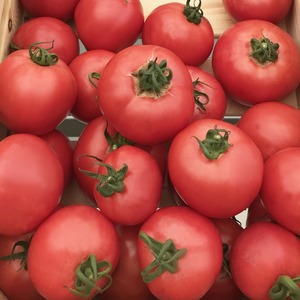Advantages and disadvantages of Torbay tomato: why it is worth trying to grow it
The Dutch tomato Torbay not only successfully took root in Russian beds, but also retained all its valuable qualities. Pink tomatoes do not have a high level of fruiting, but this hybrid is an exception. In terms of yield, it surpasses many traditional red varieties.
The excellent taste of ripe vegetables is complemented by an excellent presentation, which allows entrepreneurs to consider the culture for commercial purposes.
The content of the article
Characteristics and description of the variety
The f1 hybrid was launched in Holland in 2010. Registered in Russia in 2012. It is very popular among lovers of pink tomatoes. Recommended for growing outdoors and in greenhouse conditions.
Distinctive features
Bush determinant, standard, the height depends on the growing conditions: in open ground does not exceed 80 cm, in protected structures the bush reaches 1.5 m. The stem is powerful, the branches are spreading, the foliage is dense.
Reference! The term "determinant" comes from the word "determination", translated from Latin, meaning restriction. This means that such a plant has a limited growth point.
Mid-ripening, 110-115 days pass from the moment of sowing the seeds to full ripening. Fruiting is extended, in regions with a warm climate lasts until October.
The genes of the hybrid have a high resistance to dangerous diseases of the Solanaceae family, such as: verticillary wilting, fusarium. The hybrid is practically immune to top and root rot.
The yield is high, up to 6 kg of fruits are harvested from 1 seedling, provided that four plants are planted per 1 sq. m.
The culture requires a mandatory garter, even in the open field, despite the low growth and powerful stem. Ripe tomatoes are quite weighty and can break branches with their weight. In addition to the obligatory garter, the tomato needs regular pinching.
Fruit characteristics
Average weight 175-210 g, rounded shape, slightly flattened on top, pink color. The taste is excellent, sweet with a slight sourness, the pulp is juicy, the skin is strong, resistant to heat treatment. There are 4-5 seed chambers, few seeds.
The purpose in cooking is universal: suitable for fresh consumption, whole-fruit preservation and for processing. Thanks to the strong skin, ripe vegetables can withstand long storage and long-term transportation, perfectly preserving their presentation.
The photo shows the Torbay f1 tomatoes:

How to grow seedlings
Sowing seeds for seedlings begins 2 months before transplanting into the ground. In terms of time, this is the end of February or beginning of March. The final date will be determined by the climatic features of the region.
Seed preparation
The planting material is laid out on the table and carefully examined for visible defects. Grains suitable for sowing should be light in color, without visible damage or distortion. Then seed dipped in saline to determine voidness. Those that float to the surface are thrown away.
Reference! A saline solution is prepared by dissolving 1 tsp. salt in a glass of water.
After that, the remaining grains are disinfected in a weak solution of potassium permanganate for 20 minutes, washed with running water.
To improve germination, the seeds are germinated on damp gauze for 2-3 days at a temperature of 24 ° C. The gauze is moistened with warm water as it dries. As soon as the first sprouts have appeared, the seeds are ready for sowing.
Reference! Since Torbay is a hybrid, seed will have to be purchased every year.
Capacity and soil
The soil is prepared from turf, peat and humus, thoroughly mixing all the components. A little ash or washed river sand is added to the resulting mixture for ease. The soil, like the seed material, undergoes mandatory disinfection to destroy the pathogenic flora. To do this, it is spilled with a hot solution of potassium permanganate or steamed in the oven for 10 minutes.
Reference! Soil disinfection is a necessary preventive measure for diseases.
After that, the earth is poured into prepared landing containers. It can be planted in a common wooden box or in separate containers, for example, in paper honeycombs, plastic cups, peat pots. Small holes are made at the bottom of the planting containers so that excess moisture does not stagnate.
Sowing
Seeds are sown to a depth of 1.5-2 cm. They are sprinkled with earth on top, leveled, slightly moistened with a spray bottle with warm settled water. The seeded containers are covered with foil to create a greenhouse effect and left in a warm room at a temperature of at least 25 ° C.
Before emergence, the film is periodically removed and ventilated for 15 minutes.
Growing and care
 With the first shoots, the film is removed, and the containers are rearranged in a well-lit place on the windowsill. At this point, it is important that direct sunlight does not fall on the seedlings, otherwise the seedlings will receive serious burns. With a daylight of less than 14 hours, the planting is supplemented with fluorescent lamps.
With the first shoots, the film is removed, and the containers are rearranged in a well-lit place on the windowsill. At this point, it is important that direct sunlight does not fall on the seedlings, otherwise the seedlings will receive serious burns. With a daylight of less than 14 hours, the planting is supplemented with fluorescent lamps.
Moisten the topsoil as it dries. Pour with warm, settled water from a shallow watering can. After watering, the ground is loosened superficially without touching the young roots. Seedlings are not poured, otherwise the root system may rot.
After the appearance of two true leaves, the seedlings dive, seating them in separate containers. If a seedlings left in a common box, then the distance between the bushes is increased to 10 cm.
During the seedling period, at least three dressings with liquid fertilizers are carried out specifically for seedlings. Top dressing is applied along with watering, after which the soil is loosened for better absorption of fertilizers.
2 weeks before planting in the ground, the seedlings begin to harden in order to increase the immunity of plants and quickly adapt them to outdoor conditions. The procedure is reduced to being on the street for 1 hour. Gradually, this time is increased to 14 hours, while simultaneously lowering the night temperature in the room where the seedlings are brought to 13 ° C.
Reference! The pick contributes to the better development of the root system. The procedure consists in cutting off the main root by a third.
How to grow tomatoes
After 2 months, the seedlings are ready for transplanting into the ground. By this time, there are at least five real leaves on the bushes and a fully formed root system.
Landing
The ground for the tomato is prepared in the fall, dug up and mixed with humus. In the spring, the soil is dug up again, removing all weeds with roots. It is better to choose beds for tomatoes on the sunny side, protected from drafts.
Landing scheme: 40 cm is the distance between seedlings, 65 is left between the rows. For 1 sq. m place no more than 4 seedlings. Superphosphate no more than 10 g is added to the shallow wells at the bottom and filled with water. It is better to replant on a cloudy day or after sunset.
Further care of tomato Torbay F1
Regular watering is established as young bushes adapt to outdoor conditions. Watered no more than 2 times a week, with warm, settled water, under the root of the plant. The culture responds well to drip irrigation. After each watering, the soil is loosened, huddled, removing weeds with roots.
Reference! Loosening of the soil promotes better oxygen penetration for young roots.
To keep the beds moist longer, they are mulched with straw or peat. Weed mulch further supplies the necessary nutrients during decay.
The tomato loves the necessary fertilizing in the form of potash and phosphorus fertilizers only at the initial stage, before the formation of ovaries. In the future, adult plants are regularly fed with organic matter, once every 2 weeks. An infusion of mullein or bird droppings in a ratio of 1:15 is suitable as organic matter.
Attention! Tomatoes are not fertilized with fresh manure, since after such feeding, the bushes increase the green mass, and not the ovary.
Features in care and possible difficulties
When transplanting, a wooden or metal support is installed next to each bush to tie the plants. The branches do not support the weight of ripe heavy fruits, they are also fixed to the support. The best fixation option is to tie it to the trellis with soft fabric tapes. For this, two pegs are driven in from different sides of the bed and a wire is pulled and fixed between them.
To obtain the greatest quantitative return, it is important to form a bush. The plant is kept in 1 or 2 stems. When formed into 1 stem, the fruits are larger and ripen faster, but such bushes are much higher than when a bush is formed into 2 stems. All other extra shoots are removed (stepchild) so that useful substances are spent on the development of fruits, and not on the growth of unnecessary branches.
Reference! The pinching procedure is carried out in the morning, so that the wounds have time to heal by the evening. This method reduces the risk of infection.
Diseases and pests
 The genes of the hybrid have a high resistance to the main diseases of the Solanaceae family. The culture is immune to diseases such as: verticillosis, fusarium blight, apical and root rot. However, there is a risk of black leg injury. This is an intractable fungal disease. Preventive measures play a huge role here. Fungal spores are spread by high humidity and high temperatures. Monitor the condition of the beds.
The genes of the hybrid have a high resistance to the main diseases of the Solanaceae family. The culture is immune to diseases such as: verticillosis, fusarium blight, apical and root rot. However, there is a risk of black leg injury. This is an intractable fungal disease. Preventive measures play a huge role here. Fungal spores are spread by high humidity and high temperatures. Monitor the condition of the beds.
If the tomato is planted in a greenhouse, do not forget to regularly ventilate the premises to destroy the pathogenic environment. The influx of fresh air is detrimental to many pathogens. If, nevertheless, the fungus attacked, the affected bushes are destroyed, and the soil is treated with fungicides.
Of the insect pests for tomato, whitefly is dangerous, aphid and the Colorado potato beetle. A soap solution, which is used to treat the stem and leaves of plants, helps to get rid of whiteflies and aphids. Colorado potato beetle is harvested by hand, carefully examining the bushes. If there is too much beetle, they are treated with Prestige.
Important! The soil cannot be waterlogged, this provokes fungal and bacterial diseases. But drying out of the soil is also unacceptable.
The nuances of growing in open ground and in a greenhouse
The culture is bred both in greenhouse conditions and in open beds. When planted in a greenhouse, the plants can reach 2 m in height, so the plant is pinched to limit growth.
The highest rates of fruiting are observed in unprotected soil in the south. In regions with a temperate climate, it is advisable to cover with a film to maintain high yields. In the northern regions, the culture is bred in heated greenhouses. The methods of growth do not affect the taste of fruits; vegetables always have excellent taste.
When a bush is formed into 2 stems, the fruits are smaller and ripen longer. The more stems are left, the longer fruiting.
Harvesting and application of the crop
 Ripening of tomatoes is amicable, which is convenient for mass harvesting. It's easy to pick ripe vegetables from tied branches. Fruiting is long, in the southern regions it lasts until October. If the frosts came before the vegetables ripened, it's not scary, tomatoes are able to pick up color on their own at room temperature without losing their taste.
Ripening of tomatoes is amicable, which is convenient for mass harvesting. It's easy to pick ripe vegetables from tied branches. Fruiting is long, in the southern regions it lasts until October. If the frosts came before the vegetables ripened, it's not scary, tomatoes are able to pick up color on their own at room temperature without losing their taste.
The purpose in cooking is universal: for fresh salads, a variety of snacks, hot and vegetable dishes. Their strong skin makes them suitable for canning, pickles and marinades.
Also, tomatoes do not lose their taste in tomato products. For a richer color, pink tomatoes are mixed with red ones.
Ripe vegetables are subject to long-term storage and withstand long-term transportation, perfectly preserving their presentation. Due to these factors, entrepreneurs are considering a hybrid for commercial purposes.
Advantages and disadvantages
Let's start our review of this section with the positives:
 high rate of fruiting;
high rate of fruiting;- resistance to dangerous diseases;
- survival rate in all regions;
- uncomplicated agricultural technology;
- excellent fruit taste;
- amicable maturation;
- versatility in cooking;
- long-term storage;
- long transportation;
- the possibility of breeding for sale.
Negative qualities include:
- obligatory garter;
- regular pinching;
- dependence of the yield on the formation of plants;
- regular feeding;
- the inability to independently prepare seeds.
Farmers reviews
The Dutch culture is loved by many Russian gardeners. Here are some opinions.
Anna, Omsk: “I plant a hybrid in a greenhouse. When formed into 1 stem, the height of the plants is 2 m. All branches are covered with tomatoes. The vegetables are delicious and suitable for any kind of processing. Torbay is my favorite kind of tomato. "
Sergey, Rostov region: “I have been fond of Dutch cultures for a long time. But this hybrid exceeded all my expectations. I took a whole greenhouse for him. I grow seedlings myself from purchased seeds. I harvest three waves of harvest per season. I consider a bucket of tomatoes from each seedling to be the norm ”.
Conclusion
Torbay tomato hybrid is known in all regions. Not many pink-fruited tomatoes can boast a high fruiting rate. The Dutch hybrid is an exception, for which it has won widespread respect. In addition, the culture is distinguished by its immunity to most diseases and good survival rate in all climatic conditions.
Subject to the basic rules of crop rotation and agrotechnical techniques, it will delight you with excellent vegetables until the very frost.